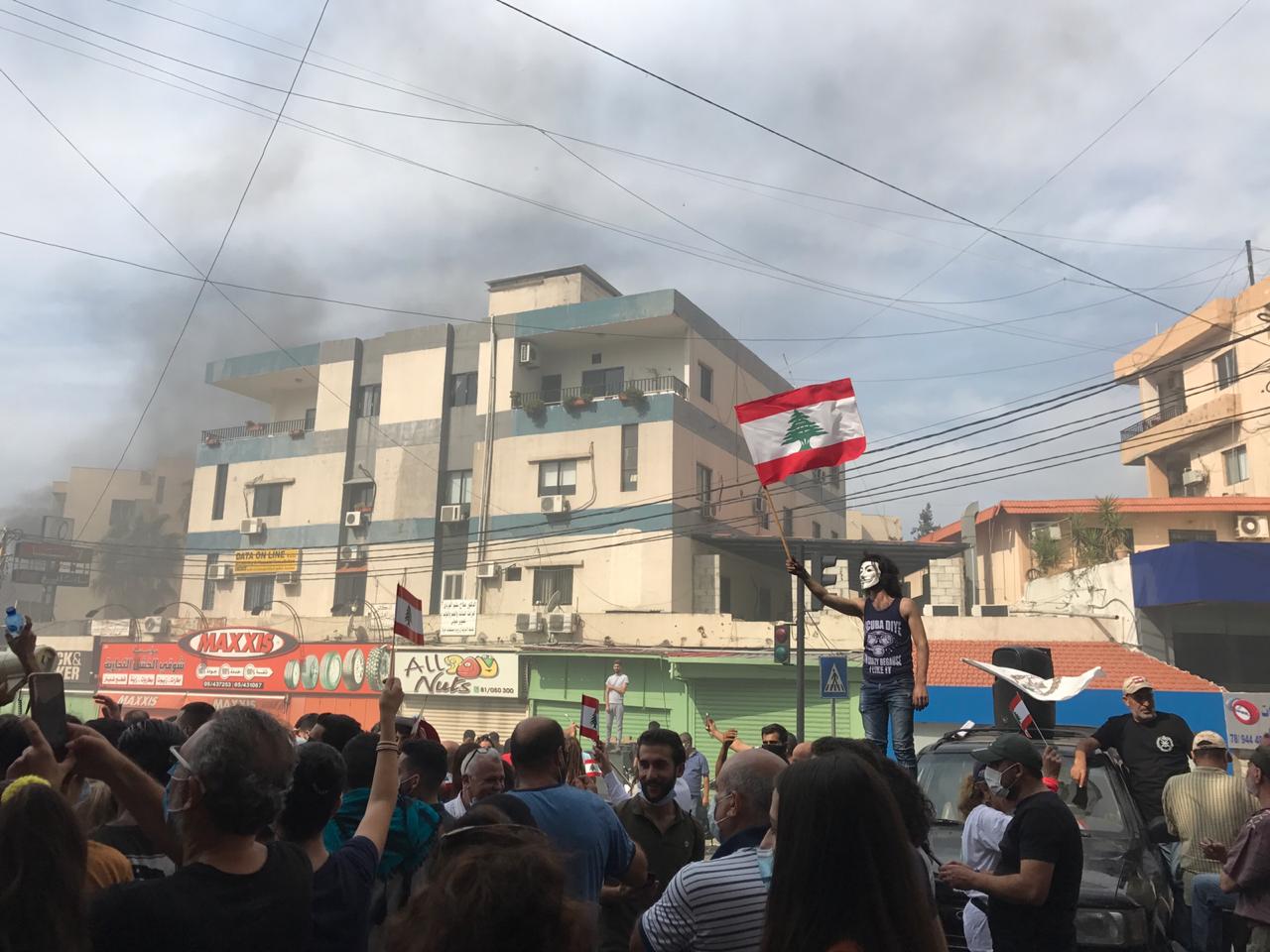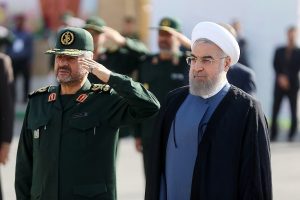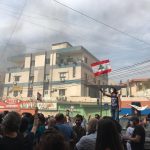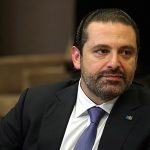By Daniel Brumberg
From Algiers to Baghdad, some quarters of the Arab world are now witnessing an uprising of a mobilized and angry middle class which––by dint of its education, economic interests, institutional resources, and globalized consciousness––is seeking a deep and sustained process of democratization. For many regional powers, not least of which Iran, this development poses a serious threat. Indeed, if the protesters in Lebanon and Iraq prevail and the non-confessional people power succeeds, Iran’s harried and vast middle classes—which have refrained from mass street protests for some time now––might rise up. The sight of Iraqi protesters attacking the Iranian consulate in the southern city of Karbala also sends shudders up the spines of Iranian leaders. Because the stakes for Iran and its allies in the Arab world are almost existential, the Islamic Republic might very well find itself openly supporting a crackdown on “counter-revolutionary” forces. Syrian President Bashar al-Assad will surely help, repaying Hezbollah for defending his regime.
Ironically, Tehran and its ally in Damascus will not be the only regional players in such a crackdown. Having spent decades funneling patronage to their Sunni allies, Saudi Arabia and the United Arab Emirates will not forego the perceived geostrategic benefits of confessional politics. But if Lebanon demonstrates the imposing regional obstacles to full-scale political change, it is not obvious that the protesters would grasp the full costs and risks that could follow from a push for a political revolution. Indeed, while the resignation of Prime Minister Saad Hariri constitutes something of a victory, the recent protests by President Michel Aoun’s supporters—who are demanding that the latter remain in office––suggest that pressures for reforming rather than radically changing the political system could grow. The rival regional forces that have subsidized sectarianism might support a limited reform—an outcome that many Lebanese might embrace or tolerate when, as seems likely, the drive to replace the old system intensifies domestic conflicts over what should replace it.
The Growing Costs of Confessional Politics in Lebanon
In July 2019, Lebanon had a public debt of over $86 billion. It is on track to amount to 158 percent of the GDP by 2021. A country with six million people, it is the third most indebted country in the world. The structural sources of the debt are rooted in a vast patronage network that has been used to subsidize the country’s confessional political system. As in many other developing countries, Lebanon’s electoral system has long provided a key conduit for the distribution of goods and services. From a strictly economic vantage point, this arrangement was a recipe for government overspending. But defenders of the system argued that clientelistic politics helped confessional cooperation, especially for voters in multi-confessional electoral districts. In these constituencies, electoral alliances across confessional lines had to be forged––although they negatively impacted a shared Lebanese identity––fostering a working consensus on economic and other benefits.
Lebanon’s 1975-1990 civil war demonstrated that this pragmatic consensus was not strong enough to overcome the centrifugal forces of confessional identity. Moreover, the logic of confessional cooperation was subverted by two developments. First, the war impelled Shia, Sunnis, Christians, and Druze to create and/or fall back on almost confessionally homogenous areas. This increased the incentive to mobilize voters along confessional lines. Second, regional powers began to meddle in Lebanon’s politics in ways that magnified sectarian conflicts. Iran and Syria led the way by supporting Hezbollah, but other regional players including Israel (which invaded Lebanon in 1978 and 1982) and the oil rich Arab Gulf states invested in the confessional system. The funneling of foreign support to different allies reduced the incentive for inter-confessional cooperation among elite groups. Meanwhile, government spending continued, ensuring not only a ballooning of the national and foreign debts, but also a corrupted economy that was dominated by the logic of sectarian clientelism rather than the multiplier effect of capitalist competition.
The polarizing effects of outside forces in Lebanon crystalized in 2005 with the emergence of the pro-US/Saudi “March 14 Alliance” and its nemesis, the pro-Iranian “March 8 Alliance.” Israel’s 2006 invasion and Iran’s ensuing campaign to widen and deepen its economic, political, and military footprint quickly followed. Funding a state within a state in the form of Hezbollah, Iran emboldened its Lebanese allies, thus helping to set the stage for the 2008 crisis when the party turned its guns against other Lebanese. However perilous, this development generated new efforts by rival Lebanese leaders and their foreign friends to find a way to climb out of the deepening hole of sectarian politics. But there was little in the way of significant progress until March 2017, when in the wake of a government proposal to raise taxes, protesters took to the streets demanding an end to the crisis of escalating corruption that had reached into the office of then-Prime Minister Saad Hariri.
Although the demonstrators focused on economic issues, their marches underscored growing public dismay with the sectarian system itself. But the June 2017 passage of a new electoral law providing for proportional representation did not presage a totally new system. Instead, its convoluted articles sustained the logic of confessional quotas, thus ensuring that the 2018 parliamentary elections produced a parliament and government that were no less sectarian than their predecessors. Because the chief beneficiaries of the elections were Hezbollah and its Iranian allies, efforts to create a new government repeatedly failed as Lebanese parties and their foreign friends jockeyed for position. The resulting governmental crisis deepened Lebanon’s economic woes while underscoring the basic reality that rampant corruption, failing government services, and escalating unemployment required major political surgery.
The Regional Struggle Over the New (and Old) Lebanon
Two major questions face Lebanon today. First, can Lebanon undertake this political surgery? Second, if the operation is a success, will it save or kill the patient? No other Lebanese leader grasps the urgency of these questions more acutely than Prime Minister Hariri. To his clear chagrin, he is caught in at least two cold wars. At home, he is squeezed between pro-Iranian leaders, who favor the status quo, and a motley mix of pro-Saudi, US, and/or European leaders who want to work the current system to limit the influence of Tehran and Hezbollah. Abroad, he is not only squeezed between Tehran and Riyadh, he is caught between Qatar and its Arab Gulf adversaries. He cannot afford to alienate the Saudis, and Saudi Crown Prince Mohammed bin Salman (MbS) in particular, who effectively held Hariri hostage in November 2017, thus signaling his displeasure of what Riyadh perceived to be his accommodating stance toward Iran. Saudi Arabia continued to express its reticence toward Hariri in January 2019, when Saudi Finance Minister Mohammed Al-Jadaan declared at the World Economic Forum (WEF) in Davos that, “We are interested to see stability in Lebanon and we will support Lebanon all the way.” But that statement came only after Qatar had pledged $500 million for Lebanon, and what is more, it provided no specifics.
It was certainly not enough to dissuade Hariri from returning to the position of prime minister the following month. His decision to work with a new Hezbollah-dominated government ended another governing crisis, thus suggesting that his desire to “turn the page and start working” (as he put it) trumped his fears about alienating the Saudis. Iranian Foreign Minister Mohammad Javad Zarif’s subsequent visit to Beirut—not to mention his meeting with Hezbollah Secretary General Hassan Nasrallah, during which he pledged to renew Iranian support for Hezbollah—signaled that Iran was reinvigorating its support for confessional patronage politics despite a rising tide of opposition to sectarianism.
That tide reached new heights in October 2019, thus confronting all the key domestic and regional players with a wave of popular discontent that threatened to engulf the entire political system. Seeking to keep his head above water, Nasrallah made a nervous speech[1] in which he walked a delicate line. While acknowledging the protesters’ economic grievances, he held that Lebanon’s economic crisis was the product of 30 years of mismanagement by successive governments. Thus, he added, “we are all responsible” for the situation. But he then warned against a “social explosion,” hinting that Hezbollah might strike back if things went too far. Less than a week later, he raised the ante. The protests, Nasrallah claimed,[2] “are no longer a spontaneous popular movement.” Rather, they were financed by foreign powers—led by Israel—who were conspiring to foment a civil war. Thus, he insisted,[3] Hezbollah rejected demands for Aoun and Hariri’s resignations and would not allow for new parliamentary elections.
There is little doubt that his hardening stance was partly prompted by media reports from Hezbollah’s southern strongholds in Tyre, Nabatieh, and Sidon, where Shia youth have declared that they were no longer afraid of Hezbollah. “It warms my heart. There are Christians, Muslims… Behind me you can see Shia and Sunnis. We are all together, we are united,” said Rami, a 54-year-old restaurant owner.”
This dissension poses a difficult dilemma for the party’s leaders and its backers in Tehran. If the demands are ignored or belittled, more Shia youth might join the opposition. But if dissent continues, it could weaken an armed party that plays a vital role in Iran’s projection of power in the region (not to mention its capacity to deter Israel from striking Iranian nuclear facilities). It is thus not surprising that Supreme Leader Ayatollah Ali Khamenei has accused Israel and the United States of “stoking chaos” in Lebanon and Iraq. Iranian President Hassan Rouhani and his chief of staff also called for stopping outside interference in the two countries.
Hezbollah’s devotees (and those of the other Shia movement in Lebanon, Amal) will see such accusations as justification for using force. Indeed, in the southern city of Nabatieh, plain clothes policemen attacked and wounded Shia protesters. Moreover, with reports that at least one Shia cleric told an attentive crowd that, “Your religion is between you and God,” Hezbollah’s leaders have reason to worry that the party is not only suffering defections, but that its Islamist ideology is alienating Shia youth. As the latter join a middle class that has had its fill of religious and sectarian dogma, the prospects for a wider split within the Shia community are becoming very real. Still, the greater danger—and irony—for Lebanon as a whole is that the demonstrations could spark a wider civil conflict. With protesters denouncing Nasrallah and insisting that he, too, must go, Hezbollah’s leaders and their compatriots in Tehran might conclude that the party must use more force, even if this risks plunging Lebanon back into the abyss of civil war. Nasrallah will surely try to avoid this dire outcome. Indeed, he has already softened his line, calling for a new government “that must listen to the demands of the people.” But this kind of tactical maneuvering is probably designed to buy time. At the end of the day, Hezbollah is facing the kind of popular uprising that will leave him with unpleasant options, some worse than others.
Is a Political Revolution Possible or Preferable?
Lebanon’s protesters have to contend with three tasks if the demonstrations continue. The first is devising a feasible plan to advance real democratic change under the umbrella of an authoritative leadership. On this score, the problem they face is that even the most carefully calibrated electoral reform will not prevent the return of sectarian parties. The second challenge is that other religious groups may not favor a total overhaul of the system. That thousands of Aoun’s supporters took to the streets on November 3, proclaiming that he is “not corrupt nor a thief” and insisting that he should remain in office, suggests that Hariri’s resignation has only sharpened the differences between those groups seeking revolutionary change and those favoring more limited reforms. Finally, the protesters must rely on a military that, despite its apparent unity and non-sectarian nature, is squeezed between the demonstrators and a far more powerful Shia militia, Hezbollah. Caught in a no-win situation, the army cannot be counted on to defend the protesters at all costs.
The Trump Administration has made matters worse by placing an indefinite hold on some $105 million in aid for the Lebanese Army. If the assumption is that this will pressure the government to meet the protesters’ demands for the appointment of a technocratic cabinet, the White House may very well be disappointed. For in holding back the aid, it is making the situation more difficult for the Lebanese military to muster the means and will to serve as a counterweight to Hezbollah.
But the more elemental problem is that no force or group inside or outside Lebanon can predict what will happen if the country tries to give up every vestige of confessional politics. During an era of escalating nationalist dogma and democratic backsliding around the globe, the boisterous protests in Lebanon, Iraq, Sudan, and Algeria suggest that pressures for democracy and pluralism may be expanding in some Arab countries just as the West is losing ground. To be sure, the domestic and regional obstacles to a political revolution remain robust because sectarian, religious, and ideological divisions are still very real and because identity conflicts continue to serve the interests of powerful forces and states throughout the Middle East.
Daniel Brumberg is a Non-resident Senior Fellow at Arab Center Washington DC, where this article originally appeared.





relentless $$ of Saudi Arabia at work. ‘Ironically, Tehran and its ally in Damascus will not be the only regional players in such a crackdown.’ misses SA, UAE, Bahrain and Egypt who have taken care of thousands of dissidents including financing ISIS and Al-Qaeda. At least there are demonstrations in Lebanon, Iraq and Iran. The same goes for ‘the boisterous protests in Lebanon, Iraq, Sudan, and Algeria suggest that pressures for democracy and pluralism may be expanding in some Arab countries just as the West is losing ground’. Again there is a semblance democracy in these countries-